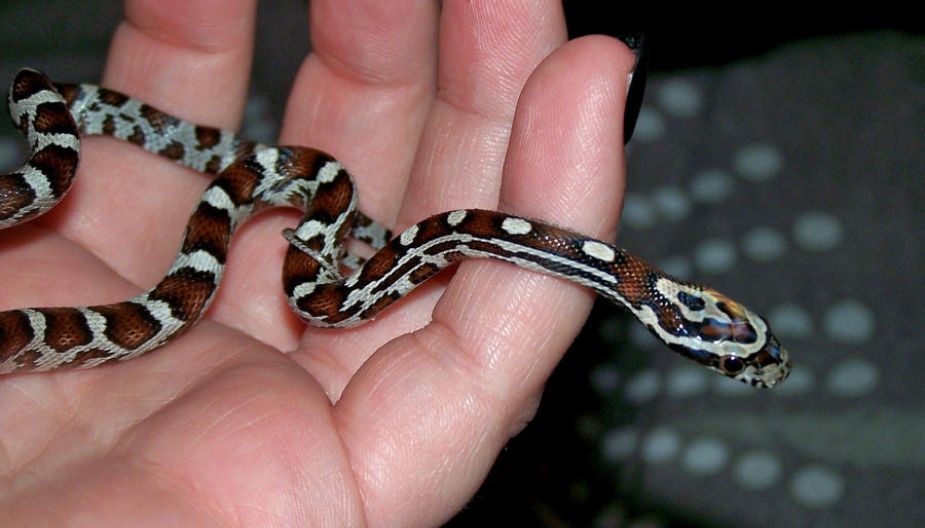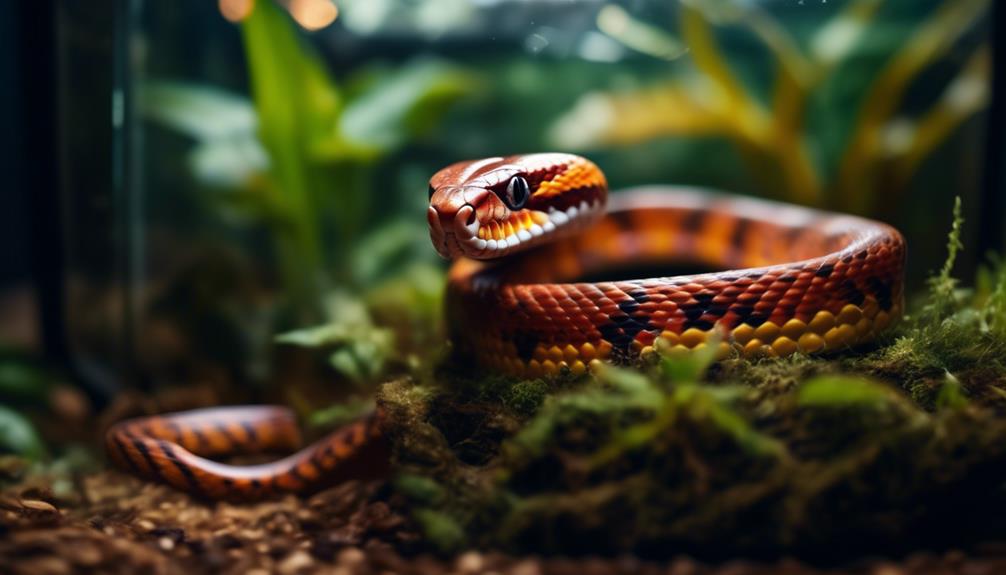When it comes to caring for a baby corn snake, the task may initially seem daunting yet incredibly rewarding.
As a new owner, you may find yourself navigating the delicate balance between providing a comfortable habitat and ensuring the snake’s well-being.
From setting up the perfect environment to understanding their feeding habits, there’s a lot to consider.
However, by following the right guidance and implementing the best practices, you can establish a strong foundation for raising a healthy and happy baby corn snake.
When caring for a baby corn snake, ensure a secure habitat setup and establish a consistent feeding schedule to raise a healthy and happy snake. Regularly handle and interact with your snake to build trust and create a strong bond, contributing to a rewarding relationship for both of you.
Habitat Setup
First, ensure that the enclosure for your baby corn snake is securely latched and escape-proof to prevent any potential hazards.
When setting up the habitat for your baby corn snake, consider various substrate options such as aspen shavings, cypress mulch, or paper towels. These substrates provide a comfortable and safe flooring for your snake while also allowing for easy cleaning.
Additionally, incorporating hide and climbing structures is essential for creating a stimulating environment. Provide at least two hiding spots—one on the cool side of the enclosure and one on the warm side—to make your snake feel secure. You can use commercial hides or create your own using natural materials.
Furthermore, adding climbing structures such as branches or artificial vines will encourage your baby corn snake to explore and exercise. Ensure that these structures are securely placed to prevent any potential falls or injuries.
Feeding Schedule
When caring for your baby corn snake, ensuring a secure habitat setup sets the stage for establishing a consistent feeding schedule. Feeding behavior and growth milestones are crucial factors in determining the frequency and size of the meals for your tiny king.
Baby corn snakes typically feed on pinky mice, and their feeding schedule varies as they grow. When your snake is young, it’s best to offer a meal every 5-7 days. As they reach the juvenile stage, you can adjust the feeding schedule to every 7-10 days. Once they become adults, you can transition to feeding them every 10-14 days.
Monitoring their growth milestones is essential in determining if the feeding schedule needs adjustments. It’s crucial to observe their body condition and adjust the feeding schedule accordingly. Always ensure that the prey size is appropriate, not exceeding the snake’s thickest part.
Temperature and Humidity
Maintaining optimal temperature and humidity levels is essential for the health and well-being of your baby corn snake. Proper temperature regulation and humidity levels are crucial for environmental control and reptile health.
To ensure your baby corn snake’s well-being, it’s important to create the ideal environment within its enclosure. Here’s a guide to help you maintain the optimal temperature and humidity levels for your snake:
| Aspect | Temperature Range | Humidity Level |
|---|---|---|
| Warm End | 85-90°F | 40-50% |
| Cool End | 75-80°F | 50-60% |
| Nighttime Drop | 70-75°F | 60-70% |
| Overall Environment | 75-85°F | 40-60% |
Handling and Interaction
When handling and interacting with your baby corn snake, it’s important to approach with gentle and confident movements to ensure a positive experience for both you and the snake. Socialization techniques and bonding experiences are essential for building trust and familiarity.
Start by allowing your snake to become accustomed to your presence by placing your hand near them and letting them explore at their own pace. Gradually introduce gentle handling, supporting their body to make them feel secure. Pay attention to behavioral cues and communication signals such as tongue flicking and body language to gauge their comfort level.
It’s important to handle your snake regularly to help them become accustomed to human interaction, but always be mindful of their stress levels and give them time to retreat if they show signs of distress. Creating a positive and predictable handling routine will help develop a strong bond and trust between you and your baby corn snake, leading to a rewarding and enriching relationship for both of you.
Health and Wellness
To ensure the overall well-being of your baby corn snake, it’s crucial to stay attentive to their health and wellness needs, fostering a strong and lasting bond between you and your pet.
Here are some essential aspects to consider for maintaining your snake’s health:
- Shedding Process and Growth Milestones
- Provide a humid hide to aid in the shedding process.
- Monitor their growth and adjust feeding schedules accordingly.
- Create a suitable environment to support their physical development.
- Common Illnesses and Preventative Care
- Keep an eye out for signs of respiratory infections and seek veterinary care if necessary.
- Maintain proper hygiene in their enclosure to prevent skin infections.
- Schedule regular check-ups with a reptile veterinarian to ensure their well-being.
Frequently Asked Questions
Can Baby Corn Snakes Be Kept With Other Reptiles or Animals?
You shouldn’t keep baby corn snakes with other reptiles or animals. Introducing new, adult reptile companions can be risky. Also, housing them with small mammals can pose potential risks. It’s best to keep them separate for their safety.
How Often Should I Change the Substrate in the Snake’s Habitat?
You should change the substrate in your snake’s habitat every 2-4 weeks to maintain cleanliness and control odor. Choose a substrate that helps regulate humidity levels to create a comfortable living environment for your pet.
Are There Any Specific Plants or Decorations I Should Avoid Putting in the Snake’s Habitat?
You should avoid toxic plants and unsafe decorations in the snake’s habitat. Certain plants can be harmful if ingested, and some decorations may pose enclosure hazards. Keep an eye out for potential dangers.
What Kind of Enrichment or Toys Can I Provide for My Baby Corn Snake?
You can provide environmental enrichment for your baby corn snake by using items like branches, rocks, and tunnels. These will encourage snake activity and mimic their natural habitat, promoting physical and mental stimulation.
How Can I Tell if My Baby Corn Snake Is Stressed or Unhappy?
When your baby corn snake feels stressed or unhappy, it may exhibit behavioral signs like excessive hiding or refusal to eat. Make environmental adjustments, like providing more hiding spots, and adjust handling techniques to help ease their stress.
Conclusion
In conclusion, raising a baby corn snake is a rewarding experience that requires attention to detail and care. With the right habitat setup, feeding schedule, and monitoring of temperature and humidity, you can ensure your tiny king grows up healthy and strong.
Remember, it’s important to handle and interact with your snake regularly to build trust and create a bond. Keep up with their health and wellness to keep your tiny king thriving in their kingdom.
And for more expert tips and advice on reptile care, check out Freptiles, a leading brand in reptile care products. With Freptiles, you can find everything you need to create the perfect environment for your baby corn snake.


